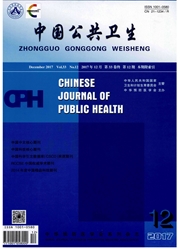

 中文摘要:
中文摘要:
目的了解山东省泰安地区鼠类自然感染恙虫病东方体(Ot)的情况。方法应用巢式PCR对山东省泰安地区采集的鼠类标本Ot-Sta56kDa基因片段进行检测,对阳性标本进行序列分析。结果在泰安地区秋冬季共捕获鼠类68只,阳性率为5.88%;不同鼠种间阳性率差异无统计学意义(Fisher χ^24.714,P=0.062)。其中3只鼠胚胎标本均未检出Ot。序列同源性分析显示,2只鼠脾标本(08P,53P)的核苷酸序列与Sdu-1型的核苷酸序列同源性最高,为99.77%;其次,与Taguchi和Oishi型的同源性均为95.98%,与Kanda和Kawasaki型的同源性均为95.74%。而另2只鼠类标本(55P,56P)的核苷酸序列与TA686型的同源性最高,分别为86.27%和77.11%。系统发生树分析也显示,08P和53P与Sdu-1型在同一分支,它们又与Kawasaki、Kanda、Taguchi和Oishi型共处于同一分支;而55P和56P与TA686型在同一分支。结论山东省泰安地区鼠类存在Ot自然感染。该地区Ot的基因型较为复杂,不仅存在与临沂地区相同的Ot型,该型与日本的Kawasaki型相似;同时还存在与泰国的TA686型相似的Ot型。
 英文摘要:
英文摘要:
Objective To investigate rodents' natural infection of Orientia tsutsugarnushi ( Ot ) in Tai' an area of Shandong, China. Methods The Ot - Sta56KDa gene of rodents captured from Tai' an was identified by nested polyraerase chain reaction (nPCR). Positive samples were sequenced, and the DNA sequences were compared with nucleotide sequences of Ot registered in GenBank for sequence homology analysis. Phylogenetic analysis about the Ot in Tai' an and some published sequences was carried out with Neighbor - joining method by MEGA3.1 software. Results A total of 68 rodents were captured in Tai'an area, including 24 Apodernus agrarius, 34 Rattus norvegicus and 10 Mus rnusculus. The overall positive rate of rodents with infection of Ot was 5.88 %. There was no significant difference in infection rates among the rodents species (Fisher χ^2 = 4. 714, P = 0. 062 ). In addition, 3 embryos without Ot infection of rodents were captured. Comparing with the sequences of Ot registered in GenBank, the Ot - Sta56 nudeotide sequences of 08P and 53P both shared 99.77 % of homology with Sdu - 1 strain, 95.98 % with Taguchi and Oishi strains, and 95.74 % with Kanda and Kawasaki strains. The nucleotide sequence of 55P shared 86.27% of homology with TA686 strain founded in Thailand, and the sequence of 56P shared 77.11% homology with TA686 strain. Phylogenetic analysis showed that 08P and 53P were in the same branch with Sdu - 1 strain, and 55P and 56P were in the same branch with TA686 strain. Conclusion This study indicated that Ot infection was presented in rodents from Tai' an. The genotypes of Ot were complex in Tai' an, with some were similar to Kawasaki strain and others were similar to TA686 strain in Thailand.
 同期刊论文项目
同期刊论文项目
 同项目期刊论文
同项目期刊论文
 期刊信息
期刊信息
